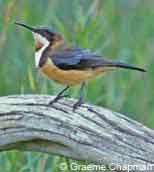About Woodlands
Meet the Animals
Conservation Tips
Puzzles
Further Info
The nectar and pollen of eucalypt flowers is a rich food source for many woodland animals, including insects, gliders, bats and birds- particularly honeyeaters and parrots. Several birds even show special physical adaptations to exploiting this food resource. For instance, the Eastern Spinebill has a ‘probing’ bill while the Little Lorikeet has a ‘brush-like’ tongue. Because woodland trees flower at different times of the year, many ‘nectar specialists’ must travel to find food. Some species, such as the New Holland Honeyeater, are locally nomadic, while others, such as the Red Wattlebird and Swift Parrot, are seasonally migratory and move considerable distances. Large, old eucalypts are particularly important for ‘nectar-dependent’ species as they flower more consistently and more profusely than small trees. Most of these birds perform vital cross-pollination services, transferring pollen from tree to tree as they feed.


Swift Parrot Lathamus discolor
There are thought to be only 1300 breeding pairs of Swift Parrot remaining, making it a nationally endangered species. From September to January the Swift Parrot breeds in Tasmania, before traveling to the mainland (Victoria, NSW and Queensland), where it spends the rest of the year. The main threats to the Swift Parrot are land clearing and collisions with cars, fences and windows.
Key habitat needs: The Swift Parrot requires nectar-rich flowering trees during autumn to winter such as Swamp Mahogany, Spotted Gum, Red Bloodwood, Mugga Ironbark and White Box. It also spends much time hanging upside down from branches searching for lerp (sap-sucking bugs). It's Tasmanian breeding habitat is dominated by Tasmanian Blue.
Did you know? The Swift Parrot is thought to be the furthest migrating parrot in the world.

Little Lorikeet Glossopsitta pusilla
The Little Lorikeet is commonly found throughout eastern Victoria and NSW and south-eastern Queensland in woodland, coastal heathland and dry forest areas. It is more rarely found in South Australia and north-eastern Queensland.
Key habitat needs: The Little Lorikeet feeds on the nectar, fruit and pollen of flowering eucalypts. It tends not to venture lower than the canopy level of these trees. Preferring open country, trees along watercourses and paddock trees, it uses hollows or deeper knot holes in trees in which to nest. The chosen nest site is scratched clean by both the male and female prior to laying eggs.
Did you know? Fledgling Little Lorikeets leave the nest at about 6 weeks and typically live until the age of 12-15 years.

New Holland Honeyeater Phylidonyris novaehollandiae
New Holland Honeyeaters are found commonly in heath, forests woodland and even gardens. Its habitat covers much of southern Australia, from south-east Queensland, eastern NSW, Victoria, Tasmania and southern South Australia and Western Australia. They are often seen in city areas and aggressively and noisily competes for food against other birds.
Key habitat needs: New Holland Honeyeaters never stay still for long - this is why they need high calorie foods such as nectar, fruit, insects and spiders. They mainly feed at lower heights in grevillea bushes and banksia trees, for example. Their long beaks and even longer tongues are ideal for extracting nectar from these types of trees and shrubs.
Did you know? The New Holland Honeyeater is quite a gregarious bird and will actually approach people.

Red Wattlebird Anthochaera carunculata
Even though the Red Wattlebird has a flash of yellow on its underbelly, it's name comes from the red flap of skin, known as a 'wattle' on its neck. It is commonly found throughout southern Australia from southern Queensland to Western Australia in forests, woodlands and gardens. It can be nomadic, traveling to find flowering trees, or sedentary, staying in one area.
Key habitat needs: The Red Wattlebird feeds on nectar, fruit and insects in flowering eucalypts, banskia and grevillea.
Did you know? Red Wattlebirds are quite aggressive, making frequent loud calls to let other birds know it is present. During the breeding season it will swoop and chase other birds which get too close to its nest.

Eastern Spinebill Acanthorhynchus tenuirostris
As the name suggests, the Eastern Spinebill is found in eastern Australia from north Queensland to Tasmania and South Australia.
Key habitat needs: This bird inhabits health, forest, woodland and sometimes garden areas. It requires flowering trees to feed from with its sharp beak which is particular suited to extracting nectar from tube-shaped flowers. It builds its nests in tree forks about 1-5 metres off the ground.
Did you know? Much like a hummingbird, the Eastern Spinebill is able to hover in the air, beating its wings at a furious pace, while it feeds.

